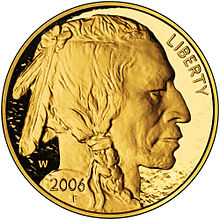American Buffalo (coin)
From Wikipedia, the free encyclopedia
| United States | |
| Value | $1510 (Proof), 4-5% above spot (Bullion) U.S. dollars |
|---|---|
| Mass | 31.108 g (1.0001 troy oz) |
| Diameter | 32.7 mm (1.287 in) |
| Thickness | 2.95 mm (0.116 in) |
| Edge | Reeded |
| Composition | 99.99% (24K) Gold |
| Years of minting | 2006–Present |
| Catalog number | BA6 |
| Obverse | |
 | |
| Design | American Indian Head |
| Designer | James Earle Fraser's design of the Indian Head nickel was modified for the American Buffalo coin |
| Design date | 1913 |
| Reverse | |
 | |
| Design | American Bison |
| Designer | James Earle Fraser's design of the Indian Head nickel was modified for the American Buffalo coin |
| Design date | 1913 |
In addition to requiring a presidential dollar coin series to begin in 2007 and redesigning the cent in 2009, the Presidential $1 Coin Act of 2005 mandated the production of a one-ounce 24-karat gold bullion coin with a face value of $50 and a mintage limit of up to 300,000 coins.
Contents[hide] |
[edit] Design
The design of the American Buffalo gold bullion coin is a modified version of James Earle Fraser's design for the Indian Head nickel (Type 1), issued in early 1913. After a raised mound of dirt below the animal on the reverse was reduced, the Type 2 variation continued to be minted for the rest of 1913 and every year until 1938, except for 1922, 1932, and 1933 when no nickels were struck. Generally, Fraser's Indian Head nickel design is regarded as among the best designs of any U.S. coins. The same design also was used on the 2001 Smithsonian commemorative coin.The obverse (front) of the coin depicts a Native American, whom Fraser said he created as a mixture of the features of three chiefs from different American Indian tribes, Big Tree, Iron Tail, and Two Moons, who posed as models for him to sketch.
Atop a mound of dirt on the reverse (back) of the coin stands an American Bison, which commonly are referred to as buffalo. The animal depicted on the reverse is believed by most to be the bison named Black Diamond, who lived in the New York City Central Park Zoo during the 1910s. It is said that Fraser had to have someone distract the buffalo while he sneaked to a position beside it to draw. Otherwise, the buffalo would turn to face him and Fraser couldn't get the profile he wanted.[citation needed]
Differences that can be noted between the nickel and the fifty dollar piece are, on the gold American Buffalo coin the mound area of the reverse of the Indian Head nickel bearing the words, FIVE CENTS, has been changed to read $50 1 OZ. .9999 FINE GOLD. Also, the motto, IN GOD WE TRUST, appearing on all U.S. gold coins since 1908, can be seen on the reverse of the newer coin to the left of, and beneath, the buffalo's head.
[edit] Fractional sizes
The U.S. Mint has indicated an expansion of the program, to include buffalo gold coins in fractional sizes. The specially-packaged 8-8-08 Double Prosperity set contains a one-half ounce gold buffalo coin.[5][edit] Distribution
Currently, all U.S. bullion coins, including the American Buffalo gold piece, are being struck at the West Point Mint in New York. According to the U.S. Mint website, only the proof version of the buffalo gold coin bears the mint mark "W" on the obverse (front) of the coin, behind the neck of the Indian; the bullion version does not have the "W" mint mark. The 2006 and 2007 coins only have been issued in a one-ounce version, but in 2008, $5, $10, and $25 face value coins were minted with 1/10 oz, 1/4 oz, and 1/2 oz of gold respectively.After a long wait by both collectors and investors, the uncirculated version of the American Buffalo gold piece was made available to coin dealers on June 20, 2006. Collectors who wanted to purchase the proof version from the mint were given the opportunity to place their orders with the mint beginning on July 22. The 2006 proof quality coin has a strict mintage limit of 300,000, with an additional enforced limit of only ten (10) coins per household. The catalog number of the 2006 proof coin at the U.S. Mint is (BA6).
The coin was created in order to compete with foreign 24-karat gold bullion coins. Since investors sometimes prefer 99.99% pure gold over the 91.67% gold used in the American Gold Eagle, many were choosing non-U.S. coins, such as the Canadian Gold Maple Leaf, to meet their bullion needs. With the American Buffalo coin, the U.S. government hopes to increase the amount of U.S. gold sales and cash in on the 24-karat sales, which makes up about 60% of the world gold market.
On July 22, the mint transferred two of the American Buffalo coins to the Smithsonian Institution's coin collection because of their historic value.[citation needed]
On September 26, 2008 the U.S. Mint announced that temporarily, it would halt sales of the American Buffalo coins because it could not keep up with soaring demand as investors sought the safety of gold amid the subprime mortgage crisis of the late 2000s,[6] which had also affected the price of gold.

No comments:
Post a Comment